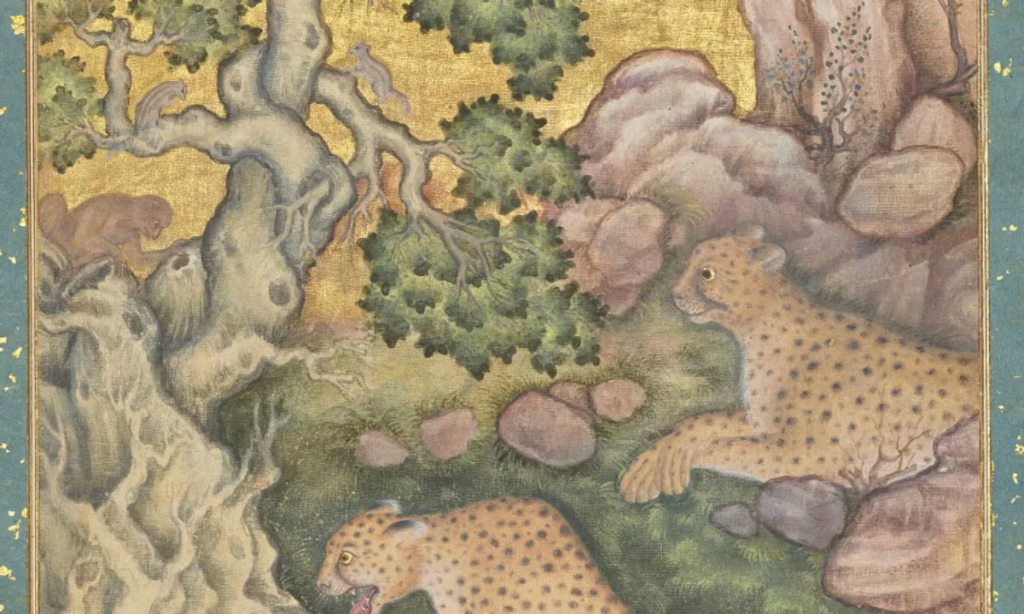In the last quarter of the 16th century, the Indian miniaturist Basawan painted a family of cheetahs against red rocks, twisting trees, and deep-gilt skies, darkening in the evening light.
Yesterday (28 October) at Christie’s in London, the work sold for £10.2m, or $13.6m (with fees), becoming the most expensive work of classical Indian or Islamic painting at auction. It comes a close second for the most expensive Indian painting at auction, after M.F. Husain’s 1954 Gram Yatra, which sold for $13.8m in March of this year, also at Christie’s.
Basawan’s A Family of Cheetahs in a Rocky Landscape (around 1575-80) came to the block as part of a single-owner sale from the collection of Prince Sadruddin Aga Khan. The 95 lots sold yesterday for £45.8m ($61m), hugely outperforming its presale estimate of “in excess of £8m”. This makes it the highest-value sale of South Asian art in history, besting the $40.2m made at Saffronart in New Delhi and the $25.5m at Sotheby’s New York, both made last month. It closes out the strongest year yet for the South Asian art market, which has seen surging interest for the region’s Modern art begin to spill over into the classical category.
From the 1960s to the 1990s, Prince Sadruddin, who was the UN High Commissioner for Refugees and the son of the spiritual leader of the Ismaili sect of Muslims, assembled one of the greatest modern collections of Indian and Islamic art. He bought from private individuals, galleries, and auctions, at a unique moment in history: after the Second World War, paintings and manuscripts brought home by British colonialists from India were coming to the market for the first time, while Armenian and European dealers (and their clients) were beginning to disperse their collections, which had been formed in the dying days of Ottoman Turkey and Qajar Iran. Consequently, Prince Sadruddin was able to pick up works of rare quality, en masse.
The 95 lots which came under the hammer yesterday provide an overview of every major school and period of Indian painting from the 16th to 19th centuries, including prime examples of art produced for the Great Mughals, the Sultans of the Deccan, the late Mughals of the anarchic 18th century, European adventurers in courtly Awadh, and curious, inquiring servants of the East India Company, such as William and James Baillie Fraser.
Eight paintings from the Fraser Album together made £6.2m, or $8.2m, including portraits of Afghan horse merchants and Pashtun tribesman, whose turbans and haircuts are depicted with such accuracy that they might have been plucked out of Kandahar or Peshawar today.
Portrait of a Peearee Jan (Pari Khan), Fraser Album, Delhi, India (1815)
The sale also depicted sex, fashion, and luxury in early-modern India. Another Fraser Album portrait shows the teenage courtesan ‘Peearee Jan’ in striking flared silk trousers, while a series of erotic miniatures from Alwar and Delhi hints at the lives of decadent north Indian aristocrats in the 1820s.
The sale’s top lot, A Family of Cheetahs, also offered compelling visual evidence of the forging of Indian art out of Persian origins. Under the patronage of the connoisseurial emperor Akbar (r.1556-1605), Indian artists like Basawanbegan to experiment with the artistic traditions of the Persianate world. The Mughal court was full of Persian emigré notables, who brought with them the cultural memory and aesthetic taste of the royal courts of Herat and Isfahan. During the reign of Akbar’s father Humayun, a number of Persian artists also arrived in India, including the painter Dust Muhammad, whose 1550s portrait of Shah Abu’l Ma’ali sold yesterday for £2.7m, or $3.6m.
The results are in keeping with the overall trend in the market for Indian art, both modern and classical. Sara Plumbly, head of Islamic and Indian art at Christie’s, tells The Art Newspaper that she attributes the rising value of Mughal art to “the emergence of Indian buyers” with crossover between the contemporary and classical markets: “Collectors start with contemporary and then look back to the roots.”
She adds that the availability of exceptional supply has also contributed to the market growth at different levels: “Things like the Cary Welch sale at Sotheby’s in 2011 [which made £29m] set a new bench mark and really upped the game for buyers.” That sale made the previous record for Indian classical work at auction, for the early 16th-century Five Holy Men by Govardhan, for £2.6m.
Yesterday’s sale set another bench mark for Indo-Persian art, breaking the £8m record set at Sotheby’s for an illustrated leaf of the Shahnameh of Shah Tahmasp. But the market remains uneven, heavily tilted towards painting from the Indian courts.
Works in yesterday’s sale by Iranian masters, such as Reza Abbasi, long considered pre-eminent in the genre, did less well, hovering in 5 and low 6 figures. “It remains the case that Islamic [art] buyers and Indian [art] buyers remain quite different,” acknowledges Plumbly. “But institutions are bridging that gap”
